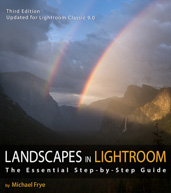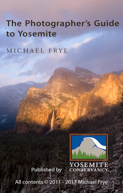Yosemite Photo Conditions
by Michael Frye | Dec 13, 2013 | Photography Tips, Yosemite Photo Conditions
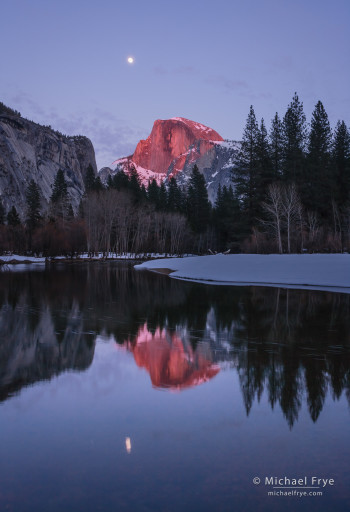
Half Dome and moon at sunset, February 18th, 2008
There’s something magical about the moon. Putting the moon in a photograph adds a sense of mystery and timelessness, and can elevate an otherwise ordinary scene into something special. Ansel Adams confessed to being “moonstruck,” and I suppose I am too.
The moon will be full next Tuesday (at 1:28 a.m. here on the west coast), and I’m sure many photographers will be trying to capture a rising or setting moon during the coming days, so I thought I would share some ideas about photographing the full moon, and clear up some misconceptions.
Misconception #1
One misconception is that moonrise or moonset photos are taken at night. They’re not: they’re almost invariably made near sunrise or sunset. After dark the contrast between the moon and the landscape is too great, and a good exposure for the moon will make the landscape completely black, while a good exposure for the landscape will wash out the moon. Around sunrise and sunset it’s possible to balance the light between the moon and the landscape and get detail in both, yet have a dark enough sky for the moon to stand out clearly.
Misconception #2
Another misconception is that moonrise or moonset photos are made on the date when your calendar says “full moon.” This can work if the terrain is flat, or you’re at a high vantage point. But if there are mountains or ridges blocking your view of the horizon, you’re better off photographing a moonrise one to three days before the full moon, and a moonset one to three days after the full moon. While the moon won’t technically be full, it will look full enough, and be in a better position than on the actual full moon night. Here’s why:
(more…)
by Michael Frye | Nov 6, 2013 | Yosemite Photo Conditions
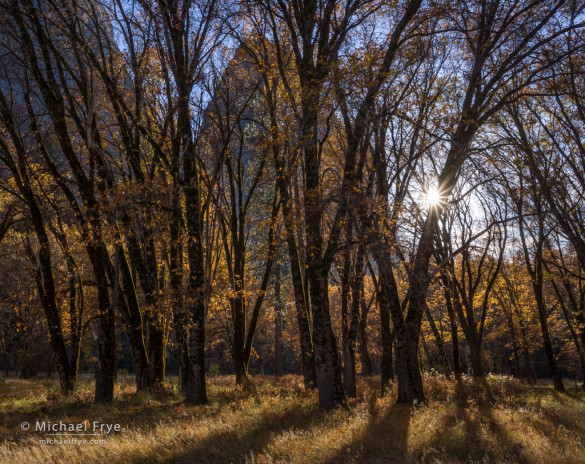
California black oaks in El Capitan Meadow, autumn, Yosemite NP, CA, USA
I’m flying to Dallas today to teach a Lightroom workshop for the Sun to Moon Gallery, but I wanted to give you a quick update on the fall color in Yosemite Valley. And there’s still plenty of color. The yellow big-leaf maples are mostly gone, and the dogwoods are also past peak, but the black oaks were close to peak when I left the valley on Saturday, and the cottonwoods were still at least 30% green. Leaves tend to linger on the oaks, so I expect both the oaks and cottonwoods will look good for at least another week.
I made the photograph above last Wednesday, and if you look closely you can see that there’s still a touch of green in some of the leaves. The image of cottonwoods below was captured on Thursday, and again you can still see some green leaves. It’s not uncommon for these trees to peak in early- or even mid-November in Yosemite Valley. Fall isn’t over yet!
— Michael Frye
(more…)
by Michael Frye | Oct 25, 2013 | Yosemite Photo Conditions
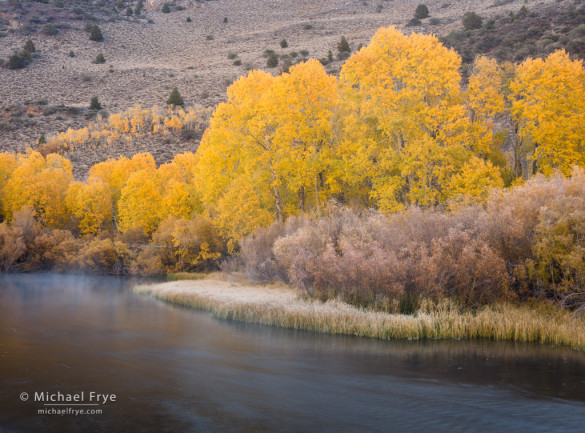
Autumn along a creek in the eastern Sierra Nevada, Inyo NF, CA, USA
I just returned home after spending nearly two weeks on the eastern side of the Sierra. It was fun spending so much time among all the yellow and orange leaves, and we had two wonderful groups for our workshops.
We had cooler-than-average weather in September and early October, which set things turning early this year. Despite that, there was still a lot of color around the June Lake Loop and lower Lundy Canyon when we left on Wednesday. This image, from Wednesday morning, shows the diversity of eastern-Sierra habitats, with a creek, aspens, willows, and sagebrush-covered hillside.
(more…)
by Michael Frye | Oct 11, 2013 | Yosemite Photo Conditions
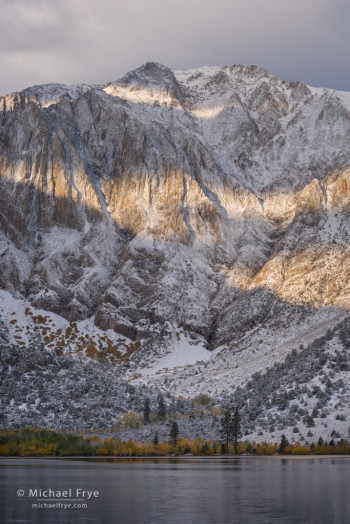
Bands of sunlight on Laurel Mountain from Convict Lake, Inyo NF, CA, USA
On Tuesday Claudia and I headed over Tioga Pass to Lee Vining. Forecasts called for snow above 7000 feet on Wednesday, so we were trying to get over the pass before the road closed to photograph the snowstorm and its aftermath.
And snow it did. Five or six inches fell at higher elevations on Wednesday, covering the mountains, pines, and aspens. I was like a kid in a candy store; I saw photographs everywhere I looked. I haven’t had time to process or post anything until now because I’ve been spending every spare minute behind the camera, but here are two images from Thursday morning at Convict Lake, and I’ll post more when I get the chance.
Tioga Pass reopened today, so we’re headed back home to Mariposa for a couple of days, but so far the cold and snow haven’t adversely affected the aspens. While the color at some of the higher elevations areas is past peak, many of my favorite lower-elevation areas like June Lake Loop and Lee Vining Canyon still have a mix of green and yellow leaves, so it looks like the color should last a while longer.
— Michael Frye
Related Post: Signs of Autumn
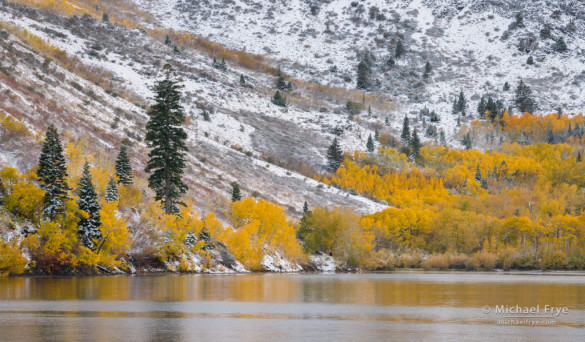
Autumn color along the shore of Convict Lake, Inyo NF, CA, USA
(more…)
by Michael Frye | Oct 1, 2013 | Announcements, Yosemite Photo Conditions
It’s official: the impasse in Washington has led to a government shutdown, and all national parks will be closed, including Yosemite. Apparently the Tioga Road will remain open to through traffic, but no parking will be allowed. “Through” roads are supposed to remain open, but it’s unclear at this point whether that means any other roads will be open in Yosemite besides the Tioga Road. Visitors staying in campgrounds or hotels within the park will have 48 hours to vacate.
There’s not much information coming from the park, no doubt because most of the park service employees have just been furloughed! I’ll let you know if I get any further information.
— Michael Frye
by Michael Frye | Sep 25, 2013 | Yosemite Photo Conditions
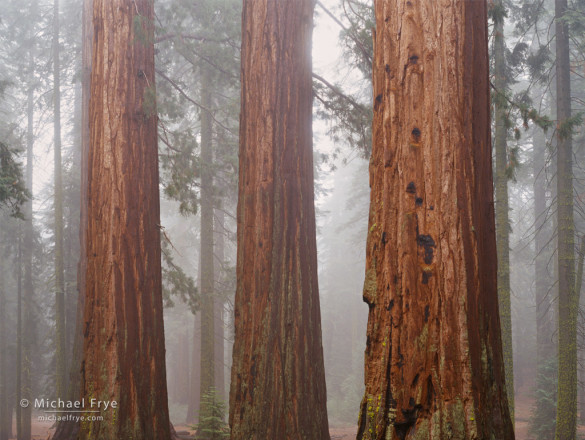
Giant sequoias in fog, Mariposa Grove, Yosemite NP, CA, USA
I thought this was an interesting story in the L.A. Times about efforts to save Yosemite’s giant sequoia trees and old-growth sugar pines during the Rim Fire. Sounds like it was quite dramatic (though perhaps the writer played up the drama a bit).
Today the fire is almost out. They’re still listing it as only 84% contained, but that’s because they’re letting it burn slowly into remote and rocky areas east of Cherry Lake and north of Hetch Hetchy. Elsewhere the fire is smoldering here and there within the containment lines, but rain and snow last Saturday doused a lot of that activity, and smoke from the fire has diminished greatly. All the main roads inside and outside the park are now open.
(more…)













